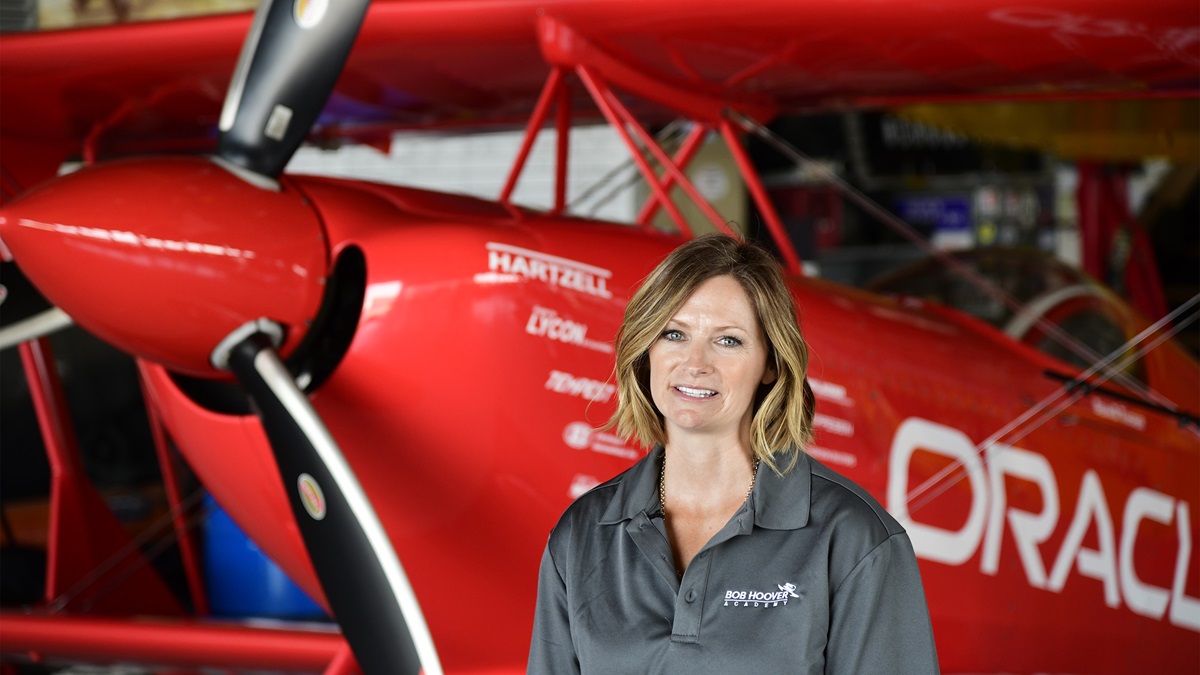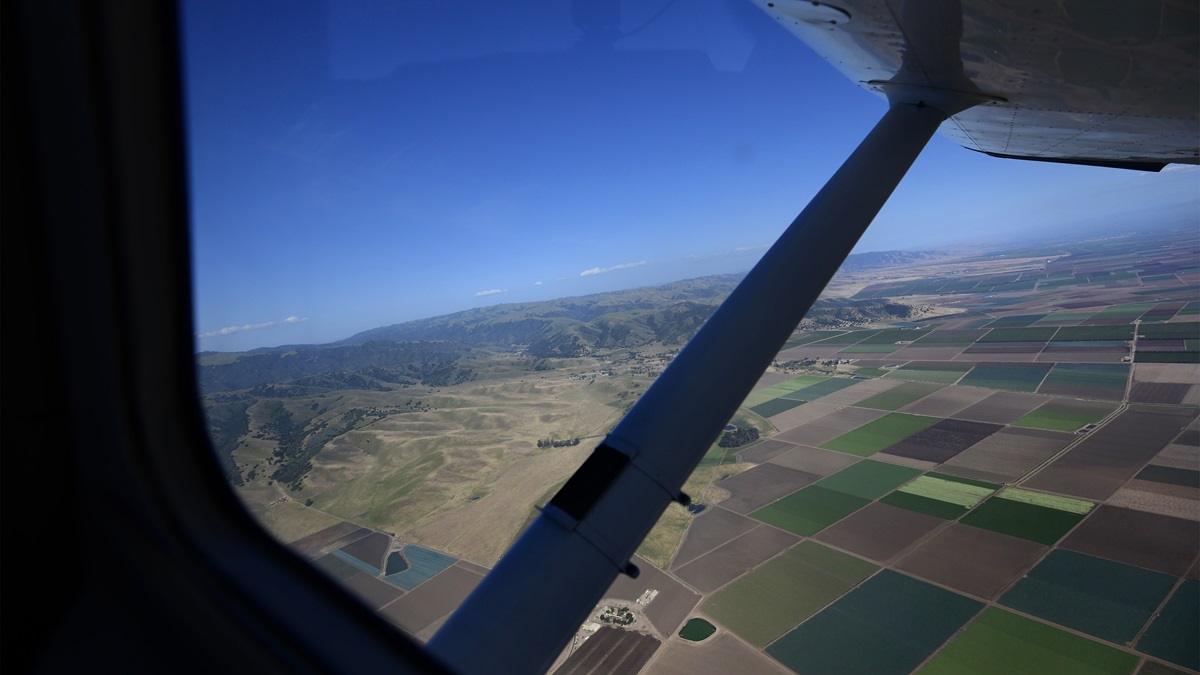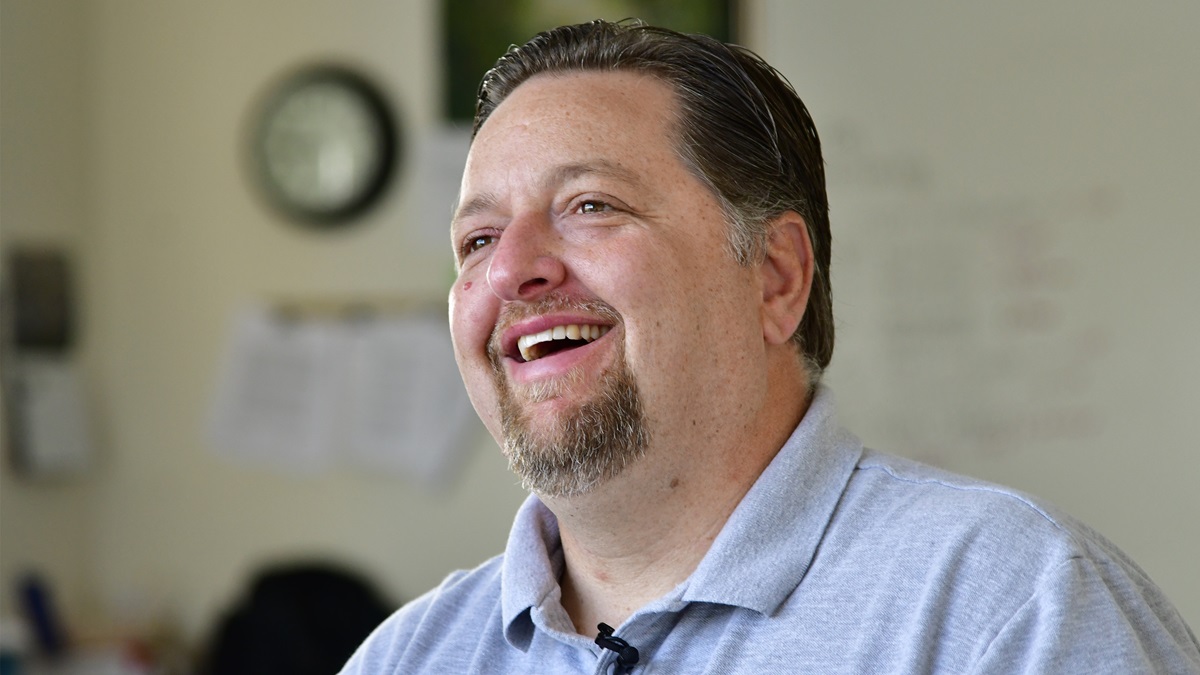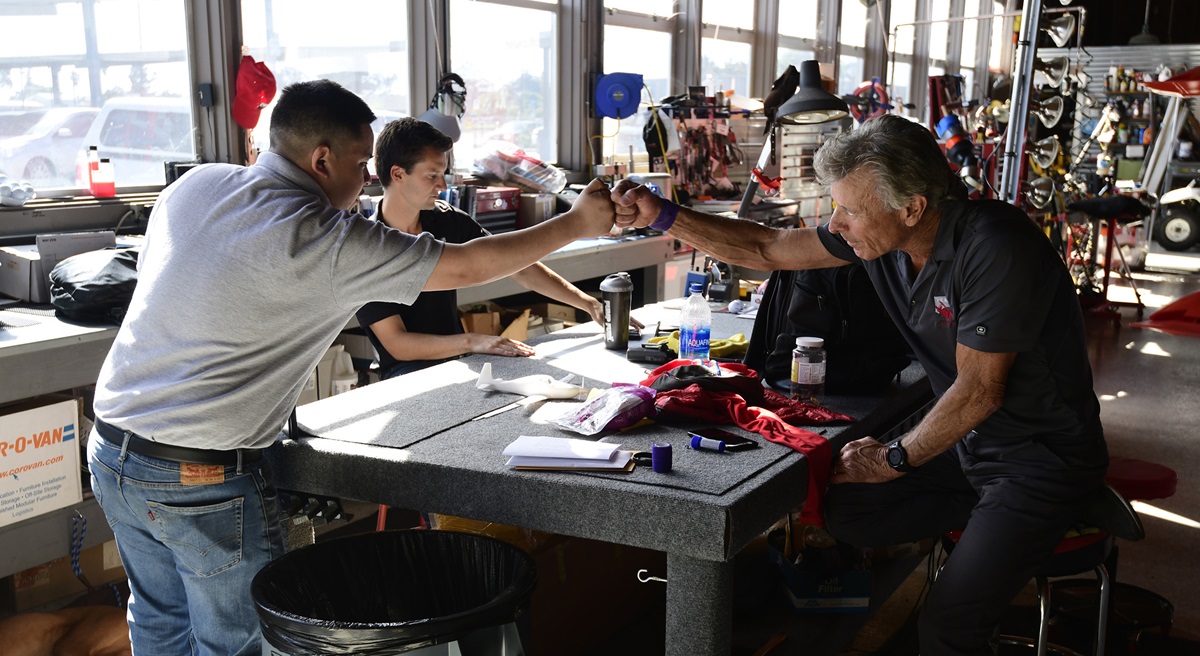Bob Hoover Academy builds confidence, solos at-risk youth
Up next: First graduate to earn A&P certificate
Sean D. Tucker is 3,500 feet above Salinas Valley in the Bob Hoover Academy’s Cessna 152, flying low and slow rather than screaming over the countryside in one of his aerobatic aircraft. He hasn’t flown the model in years, but the ear-to-ear grin speaks volumes as blue sky fills the windscreen and a quilted patchwork of family-run farms spreads out between two craggy mountain ranges in an area known as the “salad bowl” of the United States.
We were flying above Tucker’s verdant Central California home turf in the same blue-and-white aircraft that four of the 20 at-risk high school students attending the Bob Hoover Academy flew during their first solos.
He whoops and hollers as he powers the Cessna up and climbs out at a respectable 700 fpm. He chuckles as the little airplane picks up speed during a left turn down-valley and marvels at the view. “Look how clear the valley is, it goes for 50 miles and it’s beautiful,” he comments. “I sprayed just about every single one of these fields. I was a crop duster in this valley for 10 years. That’s 1,000 hours per year in helicopters and a lot of sunrises.” He built scores of personal relationships along the way.
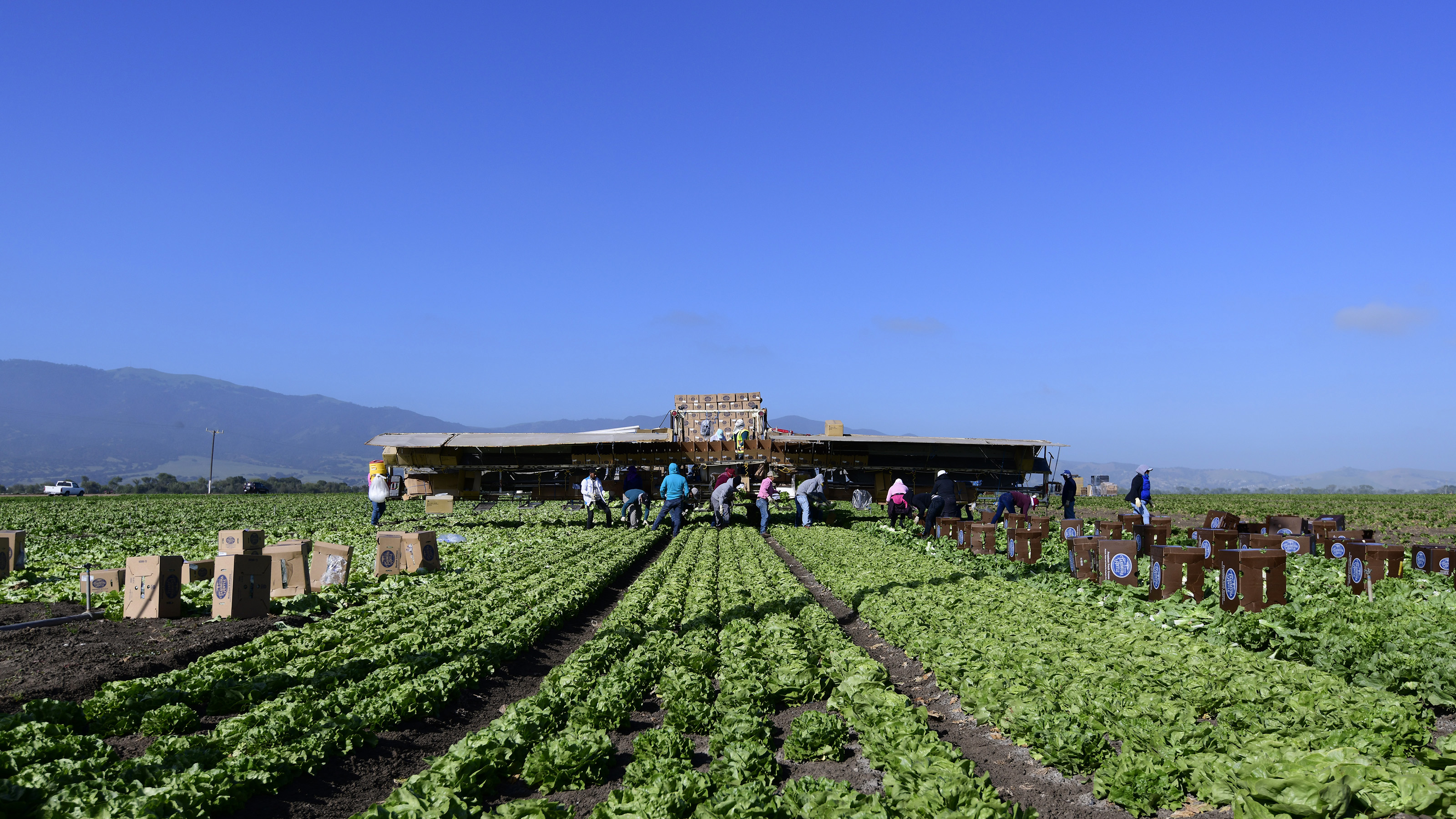
“All the vegetables that we grow here go off to America,” he explained. “All the shipping houses, the coolers, the infrastructure—this valley is so rich and fertile it can grow about three lettuce crops in a growing season. This is all high-dollar stuff and it’s all hand-labor to harvest it.”
The problem for local youth is that their parents are often in the fields harvesting crops from sunup to sundown and Tucker laments that it leaves idle time for serious mischief.
The Californian newspaper reported in February 2018 that among cities of similar size, "Salinas' homicide rate remained the highest in California, according to preliminary 2017 statistics from the Federal Bureau of Investigation." Salinas Mayor Joe Gunter said in a promotional video that the city topped a list for youth homicides in the United States. The Centers for Disease Control and Prevention noted that youth violence was a "leading cause of injury and death for young people aged 15 to 24 years."
“There are gangs patrolling here and there’s a 24/7 assassin squad,” Tucker confided. The students are “broken when we get them, but we’re putting them back together and they’re tough.”
From our view in the tiny Cessna’s cockpit, the problems of teen dropouts, gang violence, and murder rates seemed far away but they are close to Tucker’s heart.
“I loved the farmers, I loved the handshake deals, and I loved the field-workers. They were hardworking, and everybody was on the same page. It was really salt-of-the-earth stuff. I’ve made some very dear friends and we were truly a community. Some of these farms have been around for a hundred years,” he noted.
The airshow performer was taking a break from three-a-day aerobatic practices in his 400-horsepower Oracle III biplane to demonstrate how the aviation curriculum at the school he co-founded with his son Eric was the perfect classroom for at-risk and underserved teens learning science, technology, engineering, and math (STEM).

“You’ve got to learn about Bernoulli’s theorem, physics, and all that kind of stuff where the wing doesn’t have lift,” Tucker explained as he explored the “feathered edge” just above the trainer’s stall break when a horn barked its warning. “Oh boy … oh boy!” he exclaimed, and the commentary continued well into the stall before Tucker expertly snapped the aircraft’s brief departure from controlled flight without losing any discernable altitude.
His agricultural flying laid the foundation for the Hoover Academy. With his farmer-friends in mind, Tucker established after-school sessions for their sons and daughters and to give the next generation hope and a future. “These kids are smart. They might be struggling academically when they start at the academy, but when they come out they are changed people. They get to redefine their dream, to have joy again, to be inspired,” he added.
Tucker said his idea for a school also struggled five years ago when he established the after-school program originally known as Every Kid Can Fly. “Our students come from broken homes and juvenile detention centers.” He said that “some have a chip on their shoulder,” but like an artist with a picture in their head, Tucker helps them come alive. “These kids are our future. They are our precious jewels and you have to give them a shot. They’re not looking for a handout. You have to grab them so they can become part of this great community that we call America.”
The school found its groove when it partnered with the Monterey County Office of Education and implemented a Monday through Friday, 9 a.m. to 2 p.m. technical career program. The aerobatic specialist renamed it after his mentor and aviation great R. A. “Bob” Hoover’s values of education, humility, dignity, and optimism.
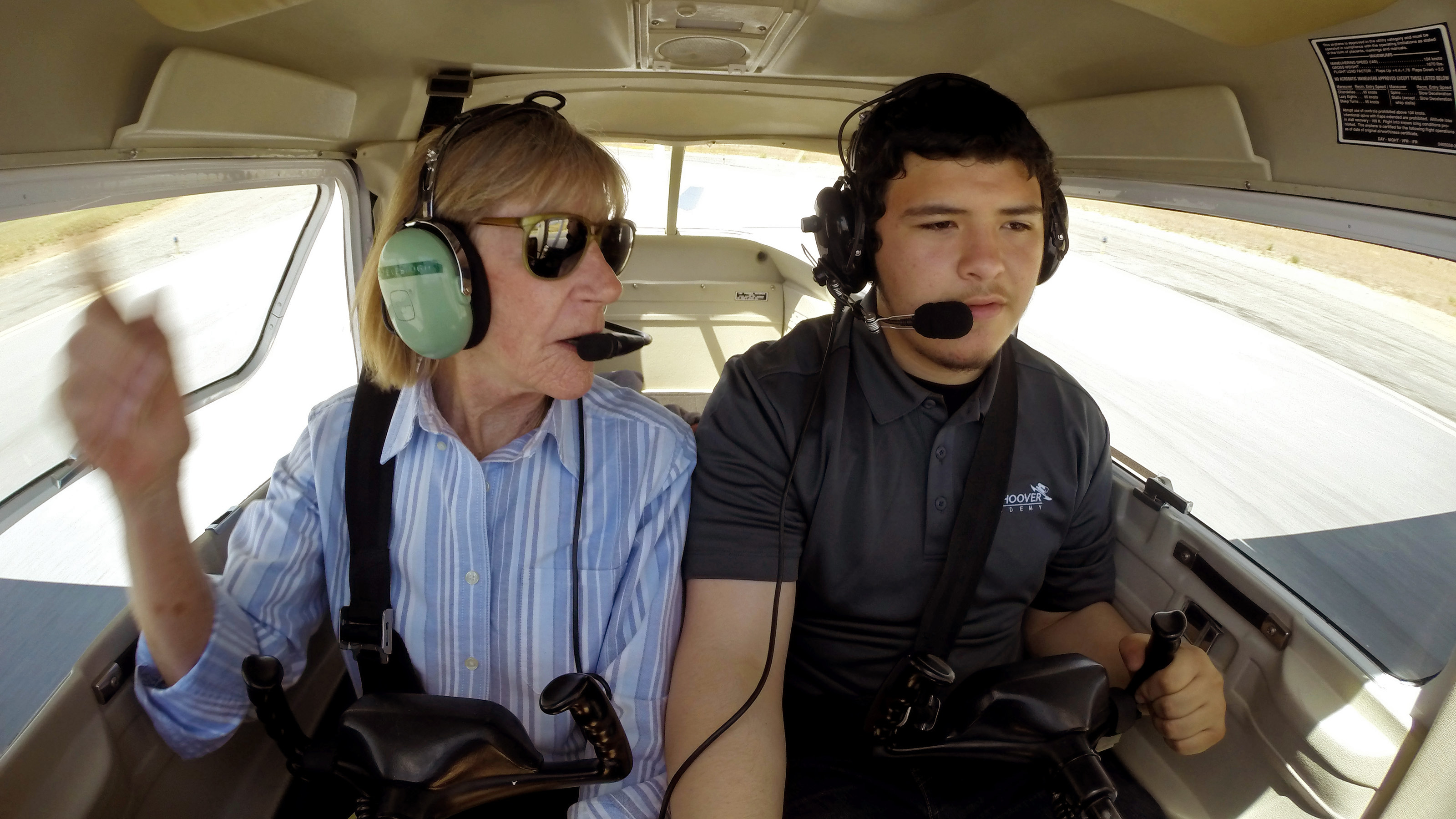
On a typical day, students hop from a traditional classroom on the Salinas Municipal Airport grounds where they learn aviation principles, history, science, English, or other core subjects to a flight simulator where aviation mentors demonstrate flight controls and concepts or to Tucker’s hangar for flying.
“We teach these kids about emergency landings before they solo,” he explained. “We teach them to be very comfortable stalling the airplane so if there’s an emergency, there’s not a panic moment. I cannot lose a kid,” he stressed. “I want to make sure they fly in the best equipment, and that they get the best skills and training, so that they can be successful. And that’s not only in the airplane, that’s in the high school curriculum as well. This is what’s so wonderful about our partnership with Monterey County—they’re striving to do the same thing. This trust they have with me—they’re betting their jobs and careers on this. This is a big, big gamble,” he confided.
Flight instructor Carol Tevebaugh fills roles as flight instructor, den mother, and drill sergeant. Monterey County teacher Christian Lamonea dishes out practical advice and encouragement between core classes. He said students hear about the academy through word of mouth and through social media. An interview process identifies their interest in aviation. Much like the real world, potential aviation students “can’t do drugs or be involved in gangster” activity, he noted.
Because he’s a student pilot himself, Lamonea said he can relate to the same fears that his students face as they build their confidence together. The school participated in AOPA’s You Can Fly High School Initiative ninth-grade STEM curriculum and Lamonea recently attended hands-on sessions during the roll out of AOPA’s tenth-grade aviation STEM curriculum.
Tucker’s airshow partner Johnny De Gennaro is often found in the hangar sharing advice, encouragement, or high fives with students after flights as they get closer to soloing the Cessna 152.
“We’re working with these kids each day, and our goal is to get these kids to graduate from high school,” said Stacey Wilson, the school’s operations manager and a helicopter pilot. “Some of them have been expelled, put on probation, and had experiences in their lives that I don’t even want to repeat.” Wilson said the program “opens their hearts again, and flying allows them to smile, to laugh, to be a kid again—and maybe for the first time in their life. It’s exciting and fun to watch.”
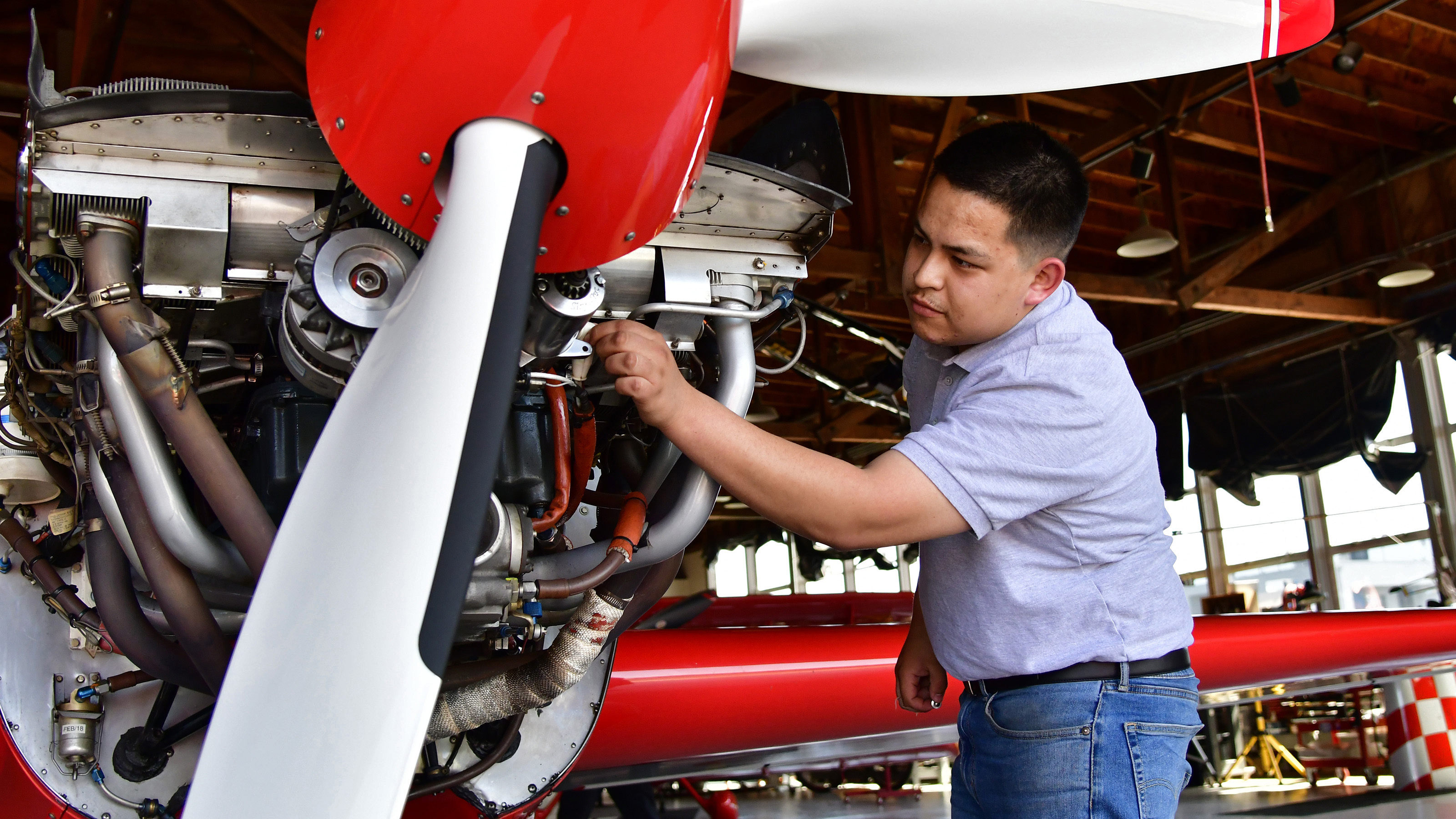
She pointed to recent graduate Martin Mendez as one of Hoover Academy’s success stories. The Gavilan Community College technical school student passed his airframe maintenance exam and had scheduled the powerplant portion of the A&P oral and practical exams for July 23. “There’s an incredible difference in where he is headed now and where he was then” when the youth first entered the aviation program.
Tucker said Mendez was so bitter when he first arrived “that he actually told the school superintendent to ‘f-off.’ Just look at where he is now—he has an iron will.”
Mendez said when he was a child and first viewed an aircraft in flight it was “almost like magic. I thought in my head ‘I’m never going to be able to do this.’” But when he heard about the Hoover Academy, the experience it could afford, and the paths to new careers, he knew he had found his home.
After several hours in the Cessna—and many more in the classroom—Mendez built up the courage to continue. His eyes lit up when he recalled the day he flew solo in the little aircraft. “It was the best day ever,” the soft-spoken aviator recalled. “Aviation is something really, really new for my family,” he added, but money is tight. He works at the Salinas airport to afford flight lessons and to buy tools to fill his mechanic’s toolbox.
When asked if his brothers or sisters would follow his footsteps into aviation, Mendez looked away and his eyes told the rest of the story. He confided that one of his dreams was to see more kids from his community pursue flying opportunities and aviation careers.
He was surprised to receive one of four $2,000 flight scholarships from the Northern California Business Aviation Association during the group’s annual safety seminar. The mechanic was applauded by 60 aviators as he cautiously approached the front of the meeting room while Tucker viewed the scene from the back of the room. After a brief ceremony, the normally shy Mendez turned to leave but stopped after a few steps. He paused, gathered his thoughts and returned to the microphone. In a strong voice, he acknowledged Tucker, the Hoover Academy instructors, and the community for opening new horizons. “I fell in love [with flying] two years ago, and now I view the world in a different way, so thank you so much.”
Diego Merida, a high school senior, was “scared to death” of getting in an airplane, but he put in scores of hours studying aviation principles and practicing flights. In mid-May he soloed the Cessna in front of a beaming Tucker and De Gennaro, who watched from the ramp.

Edgar Chavez had the strut of a pilot as he climbed from the Cessna 152 after soloing on May 31, the same day he graduated from high school. Fellow students Merida and Madeline de Campos, Tucker, volunteer pilot and mentor Steve Martin, and teachers Lamonea and Trozki Varela all gathered to cheer him on.
When Harrison Ford received the 2018 R.A. "Bob" Hoover Trophy Award in March, the pilot, general aviation advocate, and actor highlighted the accomplishments of Tucker’s academy during his acceptance speech, and he gave the program high praise for its “metaphor of flight to create social justice.”
Other members of the aviation community have rallied to help the school cement its foundation.
When Tucker put the word out that his fledgling school needed a flying classroom, Matthew Goulian, the brother of Red Bull Air Race competitor and AOPA Ambassador Michael Goulian, provided the Cessna 152 platform. Aviator and businessman Jim Slattery, who Tucker noted was a good friend of Michael Goulian’s father, Myron, paid for it. Redbird Flight Simulations Inc. owner Charlie Gregoire said the school was “an incredible program worth replicating throughout the country” and supplied a full-motion Redbird FMX simulator to prove it.
“This is a challenge—flying an airplane is a challenge,” said Tucker. “Facing your fears and conquering your fears one baby step at a time—is a challenge. And [students] using the airplane as a metaphor to challenge themselves, to build their self-esteem, to build their confidence—they’re doing something extraordinary that their peers aren’t, and that’s fabulous, that’s really fabulous,” he noted.
He uses the analogy of exploring an aircraft’s personality in all phases of flight to make a point. “Actually, we don’t leave any stone unturned when teaching these kids how to fly because there’s no upside to that. We’re not trying to take shortcuts.”
Flight instructors teach students the basics of flight as part of their daily high school curriculum and build their confidence and their foundation skill set bit by bit. With each milestone the students find out more about themselves and what they can achieve with practice and commitment.
“The kids at the Bob Hoover Academy are just fired up to be here,” said Tucker, “and what’s really cool is that they’re fired up about re-identifying themselves. They know this is something special. They get to fly this machine—and it’s just so much fun—and they really appreciate it. We give ‘em hope, man, we give ‘em hope.”



